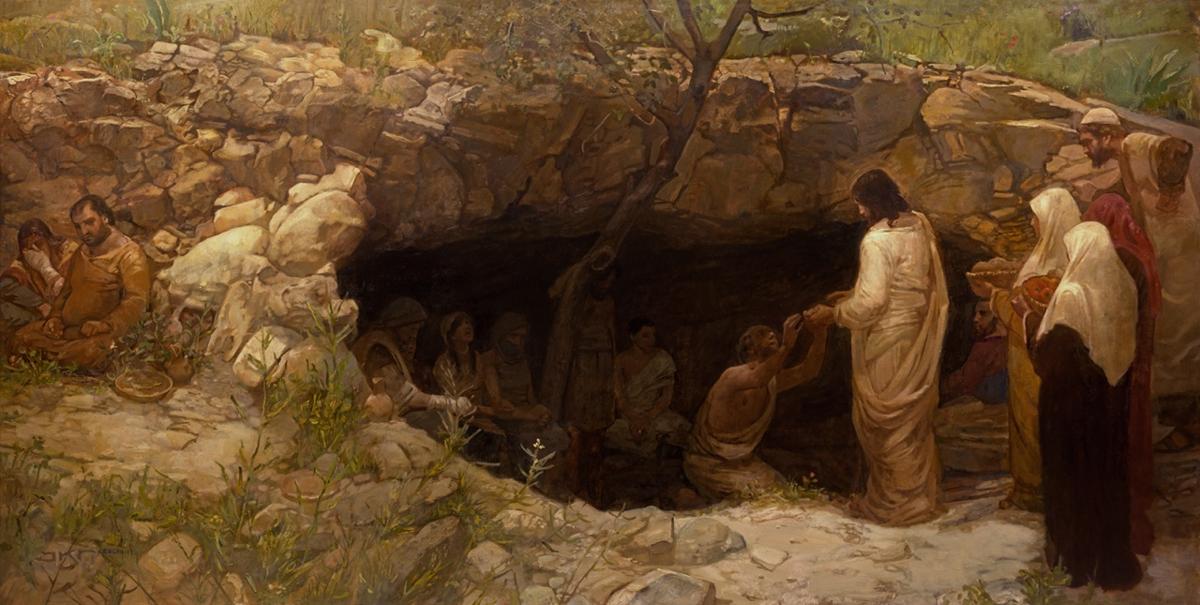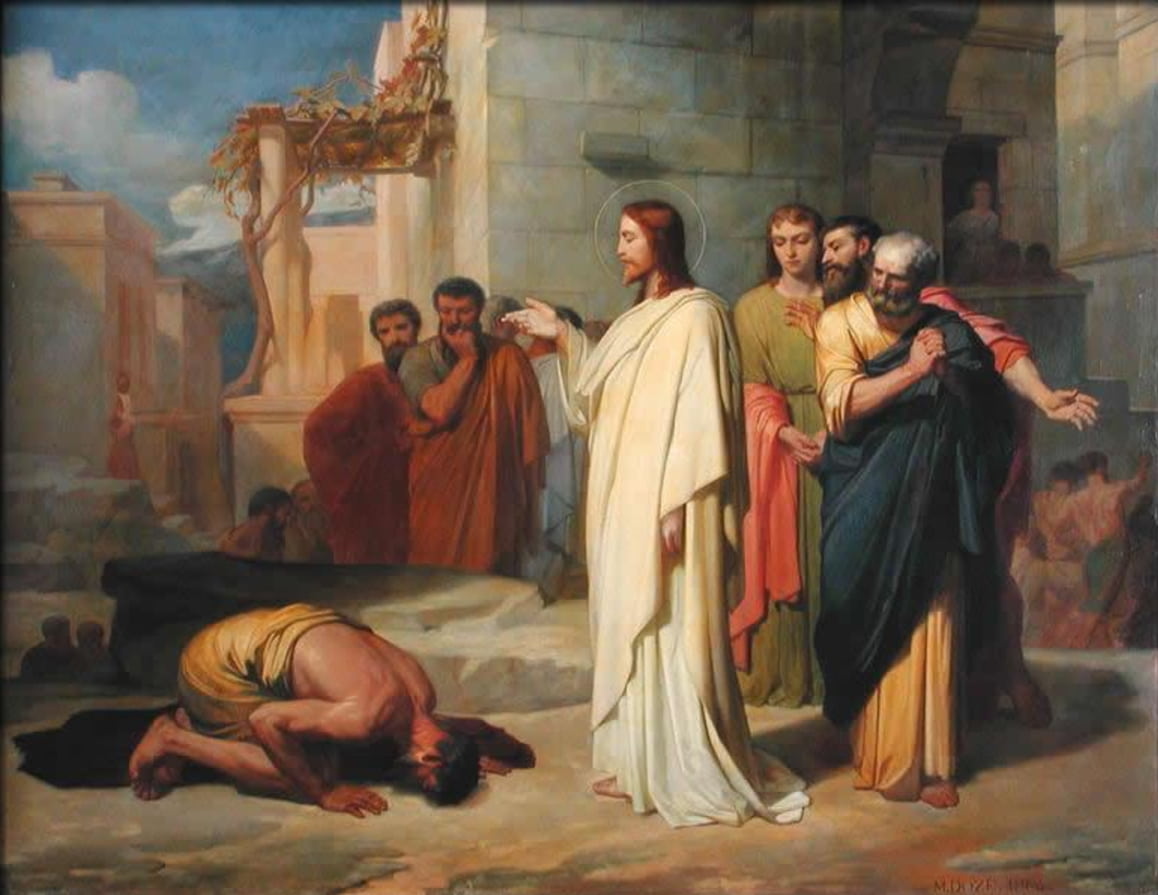March 5: Cleansing the Lepers
♫ Music:
Saturday, March 5
Scripture: Luke 17:11-19
On the way to Jerusalem he was passing along between Samaria and Galilee. And as he entered a village, he was met by ten lepers, who stood at a distance and lifted up their voices, saying, “Jesus, Master, have mercy on us.” When he saw them he said to them, “Go and show yourselves to the priests.” And as they went they were cleansed. Then one of them, when he saw that he was healed, turned back, praising God with a loud voice; and he fell on his face at Jesus' feet, giving him thanks. Now he was a Samaritan. Then Jesus answered, “Were not ten cleansed? Where are the nine? Was no one found to return and give praise to God except this foreigner?” And he said to him, “Rise and go your way; your faith has made you well.”
CLEANSING THE LEPERS
Jesus’s rule as King was demonstrated in the powerful signs and wonders He accomplished during His earthly ministry. He evidenced power over material matters (e.g., changing water to wine and multiplying the loaves and fishes), over bodily injury (e.g., healing the paralytic and the blind man), over spiritual beings (e.g., rescuing the Gerasene demoniac), over nature (e.g., calming a storm), and even over death (e.g., raising Jairus’s daughter). Today's reading recounts Jesus doing another powerful act, this time demonstrating His power over illness.
Jesus encountered a group of ten leprous men in Luke 17 as He entered a village. The term “leprosy” is used in the New Testament as a label for a variety of skin diseases (including, but not exclusively, Hansen’s disease). Luke reports that the lepers “stood at a distance,” for in the first century diseased people were required to remain removed from other people so as to protect others from contamination. This meant that diseased people could be forced to leave their families and live away from the rest of society in isolated communities (like the one pictured in the painting by J. Kirk Richards). Of course, diseased people in these isolated communities would still need to find ways to support themselves. Thich would necessitate at least some interaction with people in general society, if nothing else, to beg for food and money. In doing this, they would need to keep their distance, and they would sometimes be required to announce their contaminated condition by shouting, “Unclean!”
Jesus told these lepers to show themselves to the priests, who were the authorities in first-century Judaism to declare if a person was now “clean” and fit for reentering society. Luke notes that, as they went, they were indeed “cleansed” of their ailment. But only one of the now cleansed men took time to come back and worshipfully fall at Jesus’s feet to thank Him (see the painting by Jean Marie Melchior Doze). There were likely plenty of reasons for the former lepers to rush off bypassing gratitude (e.g., getting back to family and friends, catching up with business, tending to a backlog of home responsibilities, etc.). But Jesus notes that the only one taking time to express thanks was one of the more marginal people in the minds of the Jews (notice the faces of the bystanders in Doze’s painting). At this juncture, the healed man did not care about the social tensions between people groups; something much bigger than political correctness was at work. Instead of rushing off to submit to those who could declare him clean, this outsider chose to express gratitude to the One who made him clean.
There is another “outsider” observation to make about this uniquely Lukan story. In their distantly shouted appeal for His kindness, the ten lepers addressed Jesus as “Master.” Luke is the only New Testament writer to use this particular word and always of Jesus (Luke 5:5; 8:24x2, 45; 9:33, 49; 17:13). The basic etymology of the word (“one who stands over another”) fits these settings where Jesus is understood to have authority over others. What is particularly interesting is that Luke 17 is the only passage where Jesus is called “Master” by people who are outside of His immediate group of followers. But this may well be Luke’s point: we are all outside of Jesus’s group of followers until we recognize His authority as “Master.” This step of submissive faith brings one into the presence of the Master who has authority over all things. Jesus is the One who can make all the difference in our lives, for He is not only Master, but Lord and King.
PRAYER
Lord Jesus, Master, I recognize that You have all authority over all things, including my very existence. Nothing is impossible for You. I acknowledge that I have received many good things in life from You—things for which I have sometimes neglected to thank You in my busyness. I owe my life to You. You have heard my cry. I believe that You're my Healer.
Amen.
Douglas S. Huffman, Associate Dean of Biblical & Theological Studies
Artwork #1
Christ Among the Lepers
J. Kirk Richards
Oil on canvas
About the Artist and Art #1
J. Kirk Richards (b. 1976) is a favorite among admirers of contemporary spiritual artwork. His love of the textural, the poetic, and the mysterious has translated into a unique take on traditional Judeo-Christian themes. Richards attributes much of his love for the arts to an early emphasis on musical training in his parents’ home. Turning then from music to visual arts, Kirk studied painting with significant Realist teachers. Two years in Rome heavily influenced Richards’ palette, which often consists of subdued browns and rusts.
www.jkirkrichards.com
Artwork #2
Jesus Healing the Leper
Jean Marie Melchior Doze
Oil on canvas
Musee des Beaux-Arts, Nimes, France
About the Artist and Art #2
Jean Marie Melchior Doze (1827-1913) was a French visual artist known for his portrait paintings and biblical narratives. This piece, Jesus Healing the Leper, graphically portrays the one out of ten, who in deep gratitude returned to thank Christ and praise Him for restored life.
About the Music
“Healer”
Lyrics
You hold my every moment,
You calm my raging seas.
You walk with me through fire,
And heal all my disease.
I trust in You, I trust in You.
I believe You're my healer,
I believe You are all I need,
I believe.
And I believe You're my portion,
I believe You're more than enough for me,
Jesus You're all I need.
Nothing is impossible for You,
Nothing is impossible,
Nothing is impossible for You,
You hold my world in Your hands.
I believe You're my healer,
I believe You are all I need,
Oh, yes You are, yes You are.
And I believe You're my portion,
Lord I believe You're more than enough for me,
Jesus You're all I need,
More than enough for me,
Jesus You're all I need.
You're my healer.
About the Musician
Kari Jobe (b. 1981) serves as a worship pastor at Gateway Church in Southland, Texas. She is one of the Christian music industry’s premier female vocalists with her Dove Award-winning, self-titled debut album. She has released four follow-up albums, and has been nominated for a number of prestigious accolades.
www.karijobe.com

